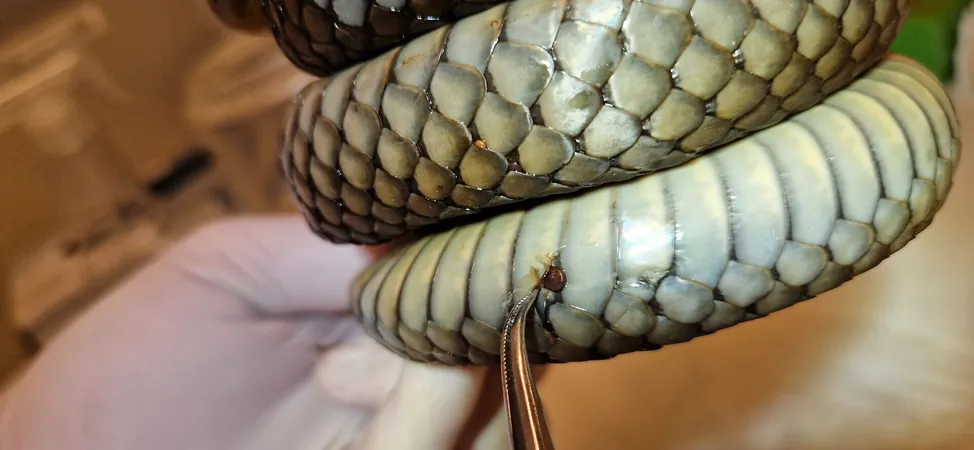
Tragic Repeat: Endangered Orca Tahlequah Grieves Again for Lost Calf
2025-01-03
Author: Ming
Heartbreaking Discovery
In a heartbreaking turn of events, an endangered orca named Tahlequah, also known as J35, has once again been observed carrying the body of her dead calf, following a similar grief-stricken display in 2018. Researchers from the Center for Whale Research report that the mother orca has been seen carrying her deceased female calf since January 1, 2024. This behavior signifies profound mourning among these highly social marine mammals.
A Return to Grief
Tahlequah first garnered global attention in 2018 when she mourned the loss of her newborn calf for 17 days, diligently pushing the lifeless body across the ocean for over 1,600 kilometers. Tragically, the calf had died shortly after birth, and the entire pod participated in carrying the body, showcasing the deep emotional bonds within orca communities.
Recent Observations
In a recent update from the Center for Whale Research, the organization expressed its sorrow over this recurring tragedy. They noted that just weeks prior to the new calf's death, they had been hopeful about its health. Yet, by Christmas Eve, researchers grew concerned due to both Tahlequah's and the calf’s alarming behaviors. By New Year's Day, officials from the National Oceanic and Atmospheric Administration (NOAA) confirmed the calamitous news: J35 was once again grieving her lost child.
Expert Insights
Brad Hanson, a NOAA research scientist, observed Tahlequah's behavior firsthand. He described how she supported her dead calf on her snout or head, diving in pursuit whenever it sank beneath the waves. Unfortunately, the calf survived only a few days before succumbing to its fate.
Emotional Capacity of Orcas
Researchers, including Joe Gaydos from SeaDoc at the University of California, Davis, have posited that such mourning behaviors in J35 demonstrate a significant emotional capacity among orcas, akin to that seen in other intelligent species such as primates and dolphins.
High Mortality Rates
Orca calves face high mortality rates, with only about 20% surviving to their first birthday, according to the Center for Whale Research. J35's loss is particularly devastating, as she has now lost two of her four documented calves. The population of southern resident killer whales has dwindled alarmingly, currently consisting of only 73 individuals. The orcas face numerous threats, including dwindling prey—particularly Chinook salmon—pollution, and increasing vessel noise, all of which pose significant challenges to their survival.
A Glimmer of Hope
Despite this tragic loss, there was a glimmer of hope for the J pod: another calf, identified as J62, has been seen alive, providing some respite amid the mourning.
Conservation Urgency
Southern resident orcas, distinct in their salmon-based diet, are endangered and can be identified by their unique markings and dorsal fin shapes. They live in matrilineal groups and are often seen breaching in the beautiful waters of Puget Sound, yet their future remains perilous in the face of environmental challenges.
A Reminder of Fragility
As the world watches J35's journey of grief, it serves as a poignant reminder of the fragility of these magnificent creatures and the urgent need for conservation efforts to protect their dwindling population from the brink of extinction.



 Brasil (PT)
Brasil (PT)
 Canada (EN)
Canada (EN)
 Chile (ES)
Chile (ES)
 Česko (CS)
Česko (CS)
 대한민국 (KO)
대한민국 (KO)
 España (ES)
España (ES)
 France (FR)
France (FR)
 Hong Kong (EN)
Hong Kong (EN)
 Italia (IT)
Italia (IT)
 日本 (JA)
日本 (JA)
 Magyarország (HU)
Magyarország (HU)
 Norge (NO)
Norge (NO)
 Polska (PL)
Polska (PL)
 Schweiz (DE)
Schweiz (DE)
 Singapore (EN)
Singapore (EN)
 Sverige (SV)
Sverige (SV)
 Suomi (FI)
Suomi (FI)
 Türkiye (TR)
Türkiye (TR)
 الإمارات العربية المتحدة (AR)
الإمارات العربية المتحدة (AR)